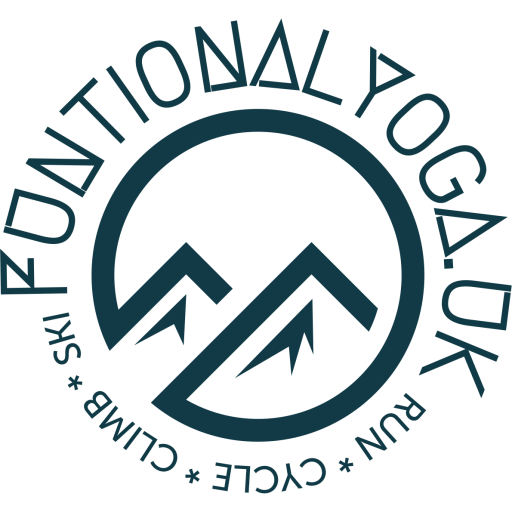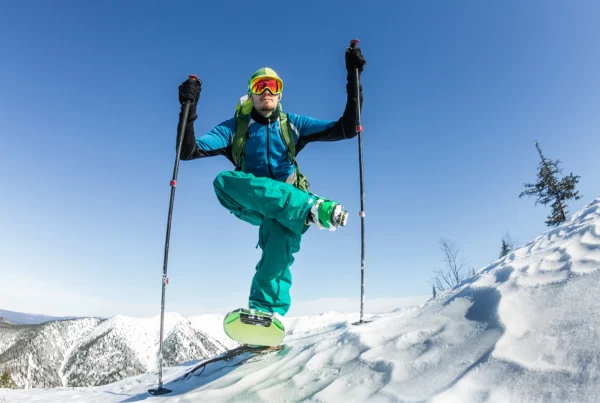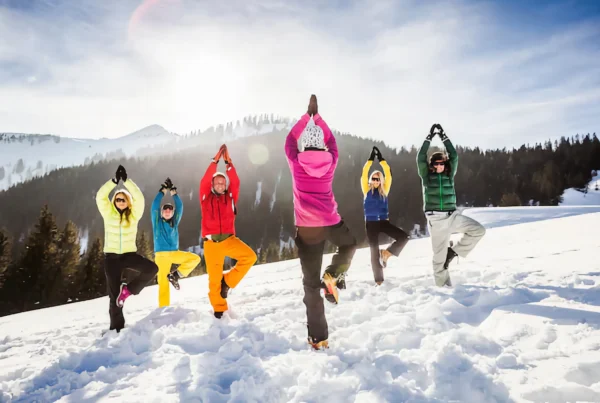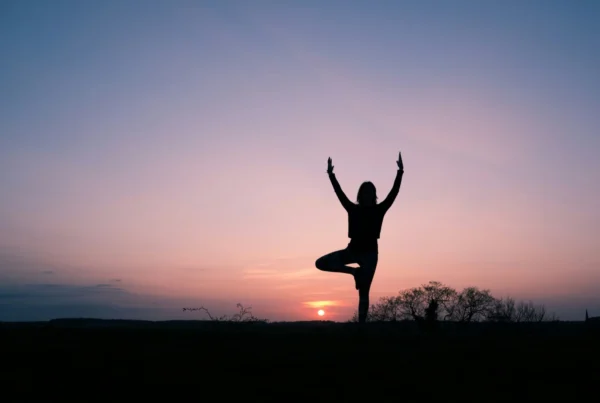
Introduction to the Synergy of Yoga and Skiing
The integration of yoga into skiing practices highlights a compelling synergy that can significantly enhance a skier’s performance on the slopes. Skiing demands not only technical skills but also a high degree of balance and flexibility, both of which are central tenets of yoga. By incorporating yoga into their training regimens, skiers can cultivate these essential attributes, promoting a more effective and enjoyable skiing experience.
Balance is paramount in skiing, as skiers navigate varying terrain while maintaining control over their movements. Yoga exercises reinforce core stability and improve proprioception, the body’s ability to sense its position in space. This heightened body awareness translates directly to more controlled and confident descents, allowing skiers to adapt swiftly to changing conditions. Moreover, the skills honed through yoga, such as focusing the mind and grounding oneself, play a vital role in maintaining poise during challenging runs.
Flexibility is equally crucial for skiers, enabling them to execute wide ranges of motion, maneuver around obstacles, and absorb impacts effectively. Yoga incorporates stretching techniques that enhance muscle elasticity and joint mobility, mitigating the risk of injuries. Skiers often experience tightness in key muscle groups, such as the hips, hamstrings, and lower back; yoga provides targeted stretches that alleviate this tension, resulting in improved comfort and posture on the slopes. Additionally, the mindful practices rooted in yoga foster mental clarity and focus, which can further enhance a skier’s performance.
Ultimately, the incorporation of yoga not only benefits physical performance but also nurtures a skier’s mental resilience. The combination of enhanced balance, increased flexibility, and mindful awareness creates a formidable foundation for skiers aiming to elevate their skills and enjoyment on the slopes. This exploration will delve deeper into specific yoga techniques and poses, outlining their applicability to skiing and bolstering the overall ski experience.
Essential Yoga Poses for Skiers
Incorporating yoga into a skier’s fitness routine can significantly enhance balance and flexibility, both of which are crucial for navigating varied terrain and making sharp turns. Here are some essential yoga poses that can aid in developing these attributes:
1. Tree Pose (Vrksasana)
Begin by standing upright, distributing your weight evenly on both feet. Shift your weight to the left foot and lift your right foot, placing it on the inner left thigh or calf (avoid the knee). Bring your hands to the center of the chest or extend them overhead. This pose improves balance and stabilizes the muscles in the legs, enhancing the skier’s ability to maintain control on uneven surfaces.
2. Warrior II (Virabhadrasana II)
Start in a standing position and step your feet wide apart. Turn your right foot out 90 degrees and bend your right knee while keeping your left leg straight. Extend your arms parallel to the ground and gaze over your right hand. This asana strengthens the legs and opens the hips, promoting the leg strength needed for powerful turns while skiing.
3. Downward-Facing Dog (Adho Mukha Svanasana)
Begin on your hands and knees, then lift your hips up and back, straightening your legs and arms. Your body should form an inverted V. This pose stretches the entire posterior chain while improving blood circulation. Better circulation contributes to endurance during long skiing sessions.
4. Pigeon Pose (Eka Pada Rajakapotasana)
Start in Downward-Facing Dog, then bring your right knee forward, placing it behind your right wrist while extending the left leg back. Keep the hips square to the ground. This deep hip opener is essential for skiers, as it helps relieve tightness in the hips and glutes, enhancing overall flexibility and range of motion.
In addition to performing these poses, it’s important to focus on breathwork and mindfulness, as they play a significant role in enhancing the effectiveness of the practice. Controlled breathing can keep the mind focused and reduce tension within the body, ultimately contributing to a smoother skiing performance.
Creating a Yoga Routine for Ski Preparation
To create an effective yoga routine tailored for skiing, it is essential to focus on enhancing both balance and flexibility, which are crucial for performing well on the slopes. Begin by assessing your current physical condition and identifying specific areas that require improvement, such as core strength, leg stability, and overall flexibility. A well-rounded routine should incorporate a variety of yoga poses that target these key areas.
Include poses that promote leg strength and stability, such as Warrior II and Chair Pose, which build endurance in the legs while encouraging balance. Additionally, integrating hip-opening poses like Pigeon Pose or Butterfly Pose will enhance flexibility and prepare your body for the dynamic movements required in skiing. Don’t overlook core-strengthening poses, such as Plank and Boat Pose, as a strong core can significantly improve your control and stance while navigating varied terrains.
The frequency of your practice is equally important. Aim to practice yoga at least three to four times a week, especially leading up to the ski season. Each session can last anywhere from 30 to 60 minutes. Consistency is key; therefore, establishing a schedule that fits your lifestyle will help you maintain this routine and reap its benefits. Dedicate specific days to your yoga practice, ideally following strength training or endurance workouts, as yoga can serve as a beneficial recovery tool.
Lastly, consider integrating your yoga routine into a broader training schedule. Combining strength training, cardiovascular exercises, and yoga will create a well-rounded preparation plan for skiing. This holistic approach ensures that you build stamina and strength while enhancing balance and flexibility, thus setting the stage for optimal performance on the slopes when the ski season arrives.
Real-Life Testimonials: Skiers Who Have Benefited from Yoga
Numerous skiers have shared their transformative experiences after incorporating yoga into their training regimens. One such skier, Emily, a seasoned alpine competitor, was grappling with recurring injuries that hindered her performance. After attending a workshop focused on yoga for athletes, she decided to integrate yoga into her weekly routine. She noted, “The improvement in my balance was almost immediate. I could feel my stability on the slopes enhance, allowing me to tackle challenging runs more confidently.” Emily’s story exemplifies how yoga can bolster the physical resilience required in skiing, demonstrating its value beyond mere flexibility.
Similarly, Mike, an amateur skier who has participated in local competitions, shared his journey of merging yoga with his skiing practice. Initially skeptical, Mike embraced yoga after realizing its potential to improve his core strength. “The poses have transformed my ability to maintain various positions while skiing. I experienced fewer falls and enhanced endurance during long days on the mountain,” he explained. His experience mirrors the feedback from numerous athletes who highlight improved agility and stability as direct benefits of yoga. The synergistic effect of practicing yoga has enabled many skiers to not only enhance their technical skills but also prevent injuries that often arise from the physical demands of the sport.
Research supports these personal testimonials, as studies have shown that athletes engaging in yoga demonstrate greater balance and a reduction in injury rates. Experts in sports science frequently endorse yoga as an effective cross-training tool that can elevate an athlete’s performance in demanding sports like skiing. The combination of breath control, focus, and physical conditioning provided by yoga allows athletes to navigate steep descents and varied terrain with greater ease. By adopting this holistic method of training, many skiers have unlocked new levels of potential that elevate their overall experience on the slopes.




